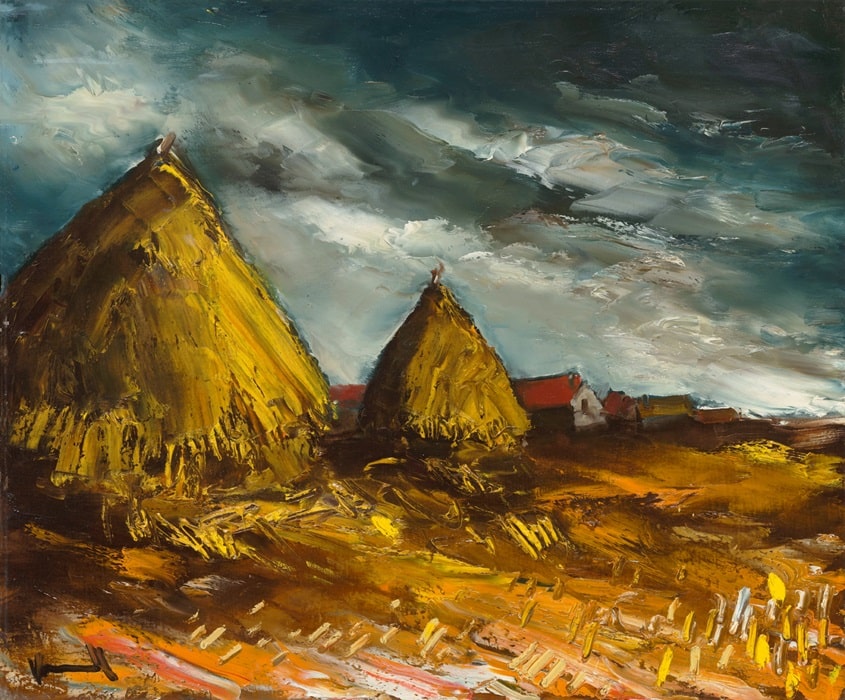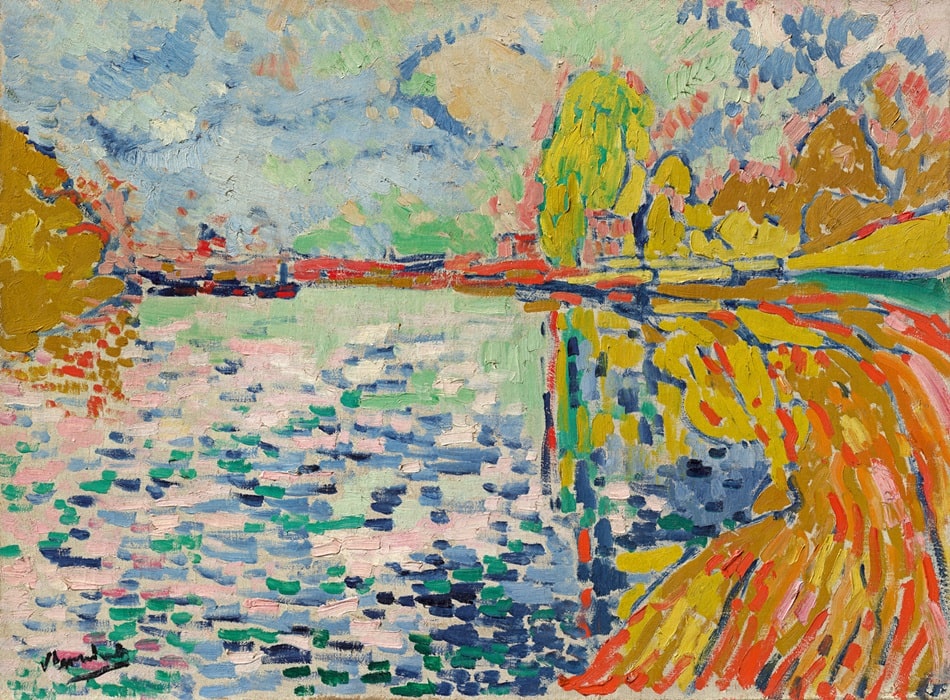The Museum Barberini in Potsdam is showing Maurice de Vlaminck. Unmixed colors, impetuous brushwork, abstract formal language: at the beginning of the 20th century, a group of artists shocked the public with a style of painting that radically deviated from previous artistic conventions. The artists known as the “Fauves” or “Wilde” – above all Maurice de Vlaminck (1876-1958) – set out on the path to modernism. Initially celebrated as a pioneer of French Expressionism, the artist’s last retrospective in Germany was almost 100 years ago.
Image above: Maurice de Vlaminck, Banks of the Seine at Bougival, 1906, Oil on canvas, 54 x 73 cm, Hasso Plattner Collection © VG Bild-Kunst, Bonn 2024
The exhibition Maurice de Vlaminck. Rebel of Modernism now provides an overview of Vlaminck’s entire oeuvre for the first time since 1929, with the emphasis on the productive creative period before the First World War, supplemented by a selection of later works. The starting point for the exhibition of 73 works, which was created in cooperation with the Von der Heydt-Museum in Wuppertal, is the nine paintings by Vlaminck in the Hasso Plattner Collection, which are complemented by loans from the Tate Modern in London, the Museo nacional Thyssen-Bornemisza in Madrid, the Centre Pompidou and the Museum of Modern Art in Berlin, among others, the Centre Pompidou and the Musée d’Orsay in Paris, the Van Gogh Museum in Amsterdam, the Museum Folkwang in Essen, the Staatsgalerie Stuttgart, the Metropolitan Museum of Art in New York, the Dallas Museum of Art and the National Gallery of Art in Washington.
The first avant-garde movement of the 20th century
From 1903, the Paris Salon d’Automne offered French and international artists a platform to present their art in opposition to the conservative policy of the Salon de Paris. In 1905, young, unknown artists who were described as “fauves” by the critic Louis Vauxcelles appeared there for the first time: Henri Matisse, André Derain, Kees van Dongen – and Maurice de Vlaminck. With their colorful works, which focused entirely on expression and emotion, they founded Fauvism as the first avant-garde movement of the 20th century. Although perceived as a collective, the artists were not united by a manifesto; nevertheless, they were united by their rejection of all previous concepts of art and their commitment to the complete freedom of the artist. Maurice de Vlaminck presented himself as an impetuous young artist. The self-taught artist with no academic artistic training cultivated a self-image as a “savage” whose work was characterized by expressiveness. As early as 1905, the art dealer Ambroise Vollard acquired the majority of Vlaminck’s studio inventory, thus enabling him to pursue a professional career as an artist.
A self-taught pioneer
Maurice de Vlaminck came to art through a chance encounter with André Derain, who encouraged the violinist, cyclist, boxer and author Vlaminck to paint. Influenced by Vincent van Gogh, a characteristic feature of Vlaminck’s Fauvist work is the appreciation of color, which he used as a means of intense expression. Like the Impressionists, Vlaminck was fascinated by the landscapes along the Seine, which he captured with impasto application of paint and bright hues. In his application of pure, unmixed colors, sometimes applied directly from the tube to the canvas, Vlaminck followed his role model Van Gogh. In the period before the First World War, Vlaminck developed an Expressionism reminiscent of the works of the Dresden artists’ group Die Brücke. From 1906 onwards, the explosive colors gave way to more subdued, darker tones and Paul Cézanne replaced Van Gogh as a source of inspiration.

Discussion in the collection context
In the years before the First World War, Maurice de Vlaminck was well received internationally: in 1912 he took part in the Cologne Sonderbund exhibition with six works, in the same year Herwarth Walden showed him in his Berlin gallery Der Sturm; the following year he was represented in the New York Armory Show. The Von der Heydt-Museum Wuppertal, cooperation partner of the exhibition Maurice de Vlaminck. Rebel of Modernism, also included Vlaminck in its collection early on:
“The Von der Heydt Museum is one of the German museums that was able to show works by Maurice de Vlaminck particularly early on. As early as 1911, August Freiherr von der Heydt acquired a still life at the Paris Autumn Salon, followed by further works in 1912 and 1913. Acquisitions such as these established the museum’s reputation as a unique venue for European avant-garde art. Organizing the first posthumous retrospective of the artist together with the Museum Barberini is only logical in view of the history of our collection, and we are delighted to be able to present the artist in his stylistic diversity to a wider audience,” says Roland Mönig, Director of the Von der Heydt-Museum Wuppertal.
Vlaminck also plays a prominent role in the Hasso Plattner Collection, which has been on permanent display at the Museum Barberini since 2020 and provides an overview of Impressionist and Post-Impressionist landscape painting like no other collection: “The Hasso Plattner Collection contains nine works by Vlaminck, including four key works from the Fauvist phase. They form the third largest group of works by any artist in the collection and no other museum in the German-speaking world has a larger collection of the artist’s work. With the exhibition and in the context of the collection, Maurice de Vlaminck can be experienced in Potsdam as an artist who continued Impressionism into the 20th century in terms of both painting and motifs and updated it with strong colors,” says Ortrud Westheider, Director of the Museum Barberini.
Daniel Zamani, curator of the exhibition at the Museum Barberini: “Maurice de Vlaminck’s work marks an important hinge between Impressionism and Expressionism. We are delighted to be able to trace his artistic career with such an opulent retrospective. We are particularly pleased about the numerous colorful works that have arrived from US collections, including incunabula of Fauvist painting from the Art Institute of Chicago and the National Gallery of Art in Washington. Another highlight are the numerous key works from international private collections that are otherwise not accessible to the public.”

Late work and propagandistic collaboration
Even though the First World War represented a personal disillusionment for Vlaminck and a caesura for his work, his painting did not lose its fascination for his contemporaries in the interwar years. In 1919, the Druet Gallery in Paris organized a solo exhibition for him; in 1929, the Alfred Flechtheim Gallery in Düsseldorf staged his first and so far only comprehensive solo exhibition in Germany.
In the course of National Socialist cultural policy after 1933, Maurice de Vlaminck’s work was also ostracized as “degenerate” and removed from the holdings of German museums. Nevertheless, and despite clearly distancing himself from militarism and nationalism in his younger years, he traveled to Germany in November 1941 at the invitation of the German propaganda squadron. He subsequently published two articles in which he openly praised National Socialist art and cultural policy. In another text, he polemicized against the avant-garde in France, as manifested in Picasso’s painting. He had his portrait painted by Arno Breker, Adolf Hitler’s declared favorite artist, and became involved in a committee for his exhibition in Paris in 1942. The former artist rebel, who saw himself as an anarchist and revolutionary, became a reactionary polemicist, an accuser of modernism.
Vlaminck’s late work has hardly been researched, probably also due to his political statements. Dark, threatening landscapes beyond all avant-garde trends dominate the late work of the artist, who took part in documenta I in 1955 and was accepted as an associate member of the Académie royale des Sciences, des Lettres et des Beaux-Arts de Belgique in the same year. His late work forms the final chapter of the Potsdam show. Even if the focus is on Vlaminck’s early Fauvist work, the exhibition also draws attention to the contradictions in the artist’s biography.

Ortrud Westheider: “Our exhibition presents Vlaminck’s work from the beginnings to his late landscapes, in which he reinterpreted Monet’s Grainstacks and Van Gogh’s Wheatfields. These paintings show the former rebel’s retreat from the avant-garde, his criticism of modernism and his pessimistic view of the world. In 1942, after a trip to Germany, he praised National Socialist cultural policy in newspaper articles. We think it is important to name this collaboration. In his art, however, there is no proximity to Nazi aesthetics. While there the peasants are portrayed as heroes, in Vlaminck’s late landscape paintings people are isolated and existentially at the mercy of the Nazis.”
The exhibition will be accompanied by a 220-page catalog published by Prestel, which was prepared by a symposium in Potsdam in December 2023. As the first comprehensive publication on Vlaminck in German, the catalog with its new insights can provide impetus for further Vlaminck research.
50 lenders from twelve countries
Curated by Daniel Zamani, Potsdam, and Anna Storm, Wuppertal, the exhibition brings together 73 works by Maurice de Vlaminck from 50 international collections. These include the Albertina, Vienna, the Artizon Museum, Ishibashi Foundation, Tokyo, the Brooklyn Museum and the Metropolitan Museum of Art, New York, the Centre Pompidou and the Musée d’Orsay, Paris, the Kunsthallen in Hamburg and Mannheim, the Museum Folkwang, Essen, the Museo nacional Thyssen-Bornemisza, Madrid, the National Gallery of Art, Washington D. C., the Staatliche Museen zu Berlin, Nationalgalerie, the Tate, London, the Art Institute of Chicago and the Van Gogh Museum, Amsterdam.
An exhibition of the Museum Barberini, Potsdam, and the Von der Heydt-Museum Wuppertal.
A guest at the Museum Barberini
During the exhibition Maurice de Vlaminck. Rebel of Modernism, the Museum Barberini is showing a small selection of Camille Pissarro’s prints in cooperation with the Kupferstichkabinett of the Staatliche Museen zu Berlin. The presentation takes place on the occasion of the 150th anniversary of Impressionism and aims to build on the exhibition The Other Impressionism. International Prints from Manet to Whistler, which is taking place at the same time in the Kupferstichkabinett of the Staatliche Museen zu Berlin. The Other Impressionism of Camille Pissarro is dedicated to the diverse effects of light and shadow in the black and white medium of printmaking.

Pissarro was one of the few Impressionists to leave behind a significant body of prints. He learned the technical skills of the printing process and experimented in it as vividly as in his painting. The artist worked with etching, drypoint, aquatint, lithography and monotype to explore the potential of each medium.
The selection of 26 graphic sheets is a foretaste of the large retrospective With an Open Eye. Pissarro’s Impressionism, which the Museum Barberini will be showing in summer 2025.
WHEN?
Exhibition dates: Saturday, September 14, 2024 – Sunday, January 12, 2025
Opening hours: Monday, Wednesday – Sunday, 10 am – 7 pm
Kindergartens and schools by appointment Monday – Friday (except Tue), from 9 am
WHERE?
Museum Barberini
Humboldtstraße 5–6
14467 Potsdam
COSTS?
Monday, Wednesday – Friday: 16 EUR / 10 EUR
Saturday/Sunday/Public holidays: 18 EUR / 10 EUR
Pupils and visitors under the age of 18: Free admission
Visitors under 25 every Thursday from 2 pm: Free admission






